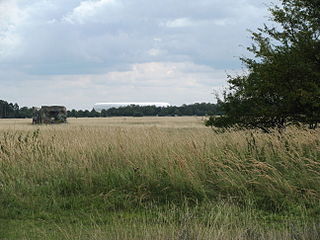
Munich is a Landkreis (district) in Bavaria, Germany. It borders the districts of Dachau, Freising, Erding, Ebersberg, Rosenheim, Miesbach, Bad Tölz-Wolfratshausen, Starnberg, Fürstenfeldbruck, and almost encircles district-free city Munich itself, which is the district seat.
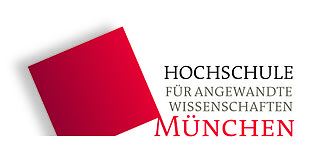
The Munich University of Applied Sciences, was founded in 1971 and is the largest University of Applied Sciences in Bavaria with about 17,800 students.
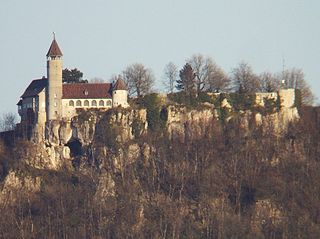
Teck was a ducal castle in the kingdom of Württemberg, immediately to the north of the Swabian Jura and south of the town of Kirchheim unter Teck. Burg Teck takes its name from the ridge, the Teckberg, 2,544 feet high, which it crowned. It was destroyed in the German Peasants' War (1525). The castle was reconstructed during the 19th and 20th centuries.

Am Hart is the northernmost of the three sub-districts of the Munich city district 11 Milbertshofen-Am Hart.

The Brown House was the name given to the Munich mansion located between the Karolinenplatz and Königsplatz, known before as the Palais Barlow, which was purchased in 1930 for the Nazis. They converted the structure into the headquarters of the National Socialist German Workers' Party. Its namesake was the result of the early Nazi Party uniforms, which were brown. Many leading Nazis, including Hitler, maintained offices there throughout the Party's existence. It was destroyed by Allied bombing raids during the Second World War.
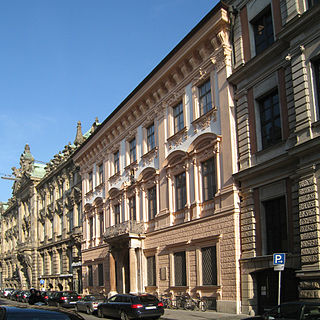
The Palais Porcia is a Baroque mansion in Munich, southern Germany, which served as residence for Count Fugger. It is Munich's oldest still existing Baroque style palace.

The Münchner Freiheit is a square in Munich's Schwabing, near the English Garden. It is a popular tourist attraction, especially during winter when one of Munich's largest Christmas markets takes place.
The Otto Falckenberg Schule – Fachakademie für darstellende Kunst der Landeshauptstadt München is a higher education academy in Munich training actors and directors, affiliated to the Münchner Kammerspiele. It was founded in 1946 as the Städtische Schauspielschule but renamed to its present name on 1 March 1948, after the director and theatre manager Otto Falckenberg. Its current director is Jochen Noch and assistant director Sigrid Herzog.
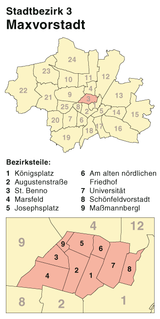
Maxvorstadt is a central borough of Munich, Bavaria, Germany and forms the Stadtbezirk 3 Maxvorstadt. Since 1992, this borough comprises the former boroughs 5, 6 and 7.

The NS-Dokumentationszentrum is a museum in the Maxvorstadt area of Munich, Germany, which focuses on the history and consequences of the Nazi regime and the role of Munich as Hauptstadt der Bewegung.

Memorial for Franz Xaver Gabelsberger is a monument located in Maxvorstadt, Munich, Bavaria, Germany. The monument is a bronze sculpture by the German sculptor Syrius Eberle. It was dedicated shortly after the hundredth anniversary of the birth of Franz Xaver Gabelsberger (1789-1849), the inventor of a cursive shorthand system. Casting was by Ferdinand von Miller.
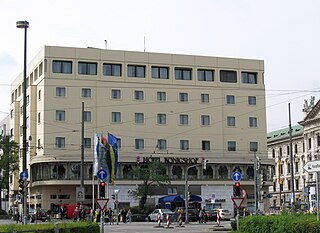
The Hotel Königshof is a luxury hotel in Munich. It is part of the hotel group Geisel Privathotels and The Leading Hotels of the World. The building is listed as a historic monument in the Bavarian heritage register. Martin Fauster, the chef of the hotel restaurant since 2004, has received one Michelin Star.

The Palais Ludwig Ferdinand is an early 19th-century palace in Munich, Germany, designed by Leo von Klenze. It is located on the Wittelsbacherplatz but forms part of an ensemble with the buildings on the west side of the Odeonsplatz. It was Klenze's own residence, then belonged to Princes Alfons and Ludwig Ferdinand of Bavaria. It is now the headquarters of Siemens.

Jazzclub Unterfahrt is a jazz club at Einsteinstraße 42 in Munich, Germany, described by Lonely Planet as "perhaps the best-known place in town, with live music". The club has over 1,200 members, though only has a capacity of about 180 people. The venue is in the old beer cellars of a former restaurant.

The Ingolstädter Straße in the Munich district of Milbertshofen-Am Hart and Schwabing-Freimann is a 4 kilometer long exit road heading North, where it connects there with Leopoldstraße.

The Rindermarkt is one of the oldest streets in Munich, which connects to the Marienplatz in the north through the former Inner Sendlinger Tor. Its continuation today forms the Sendlinger Straße, which leads to the (outer) Sendlinger Tor.
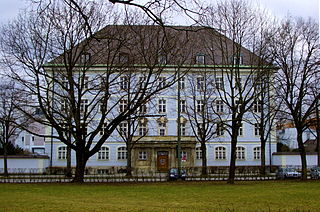
The Stadtarchiv München is the archive for the accumulating material from all municipal offices, businesses and companies of Munich; In addition, private holdings are also archived there. The Stadtarchiv is located in the Schwabing-West district. The older part of the building used to serve as a municipal military office.

The Pasinger Marienplatz is the central square of the formerly independent city of Pasing. Pasing has been a district of Munich since 1938. In order to distinguish the square from the Munich Marienplatz, it bares the name Pasinger Marienplatz ever since.



